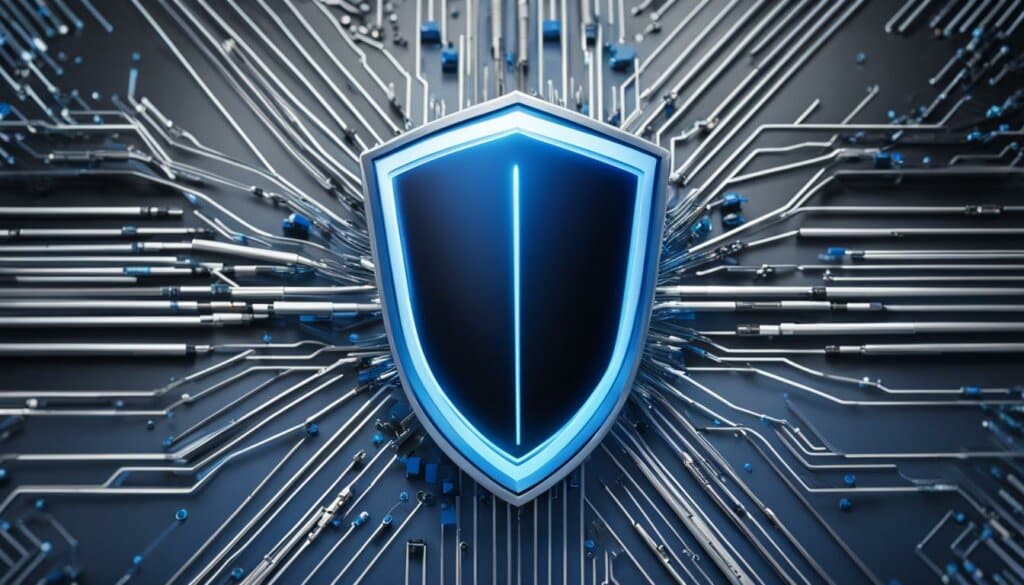Table of Contents
In today’s digital age, organizations around the world are facing an unprecedented level of risk from cyber threats. Advanced cybersecurity threats have become more sophisticated and complex, posing significant challenges to the security of sensitive data and network infrastructure.
From targeted cyber attacks to data breaches, organizations must be equipped with a comprehensive understanding of advanced threats to effectively protect their assets. This requires a deep dive into threat intelligence, cyber defense strategies, and proactive measures to prevent and mitigate cyber attacks.
In this article, we will explore the alarming rise in advanced cybersecurity threats and delve into key concepts such as threat intelligence, cyber defense, and network security. By understanding these advanced threats and implementing effective cybersecurity measures, organizations can enhance their cyber risk management and safeguard their critical assets from potential harm.
The Evolution of Cyber Threats
The world of cybersecurity has witnessed a rapid and ever-changing evolution of cyber threats. As technology has advanced, so too have the strategies and techniques employed by malicious actors seeking to exploit vulnerabilities. From the early days of simple PC viruses and malware, the threat landscape has expanded to include sophisticated cyber breaches that target organizations of all sizes.
Over the past 25 years, the development and proliferation of malware have played a significant role in shaping the current cybersecurity landscape. Hackers and cybercriminals have adapted their tactics to exploit weaknesses in computer systems, resulting in devastating consequences for individuals and businesses alike. Today, cyber breaches are more sophisticated than ever, often involving multiple stages and sophisticated attack vectors.
The rise of cyber risk management has underscored the importance of understanding and mitigating these evolving threats. Organizations must stay vigilant and adopt proactive measures to protect themselves from cyber attacks. By investing in robust cybersecurity practices and regularly updating their defense mechanisms, businesses can strengthen their resilience and mitigate the potential damage caused by cyber threats.
Table: Cyber Threat Evolution
| Threat Category | Description |
|---|---|
| PC Viruses | Simple malicious programs that replicate themselves and infect computer systems. |
| Malware | Malicious software designed to disrupt computer operations or gain unauthorized access to data. |
| Cyber Breaches | Sophisticated attacks targeting computer networks and systems to gain unauthorized access or steal sensitive information. |
| Cyber Risk Management | The process of identifying, assessing, and mitigating potential cyber threats to protect organizations from security incidents. |
As technology continues to advance, it is imperative that individuals and organizations stay informed about the evolution of cyber threats. By understanding the tactics employed by cybercriminals, organizations can proactively develop effective cybersecurity strategies and enhance their overall resilience. Effective cyber risk management is the key to navigating the ever-changing threat landscape and safeguarding sensitive information.
The Rise of Ransomware Attacks
Ransomware attacks have emerged as one of the most prevalent and damaging cyber threats in recent years. These attacks involve malicious actors infiltrating a victim’s computer or network, encrypting valuable data, and demanding a ransom for its release. The consequences of a successful ransomware attack can be devastating, resulting in financial losses, reputational damage, and operational disruptions.
According to recent data, ransomware attacks have been on the rise globally, targeting organizations of all sizes and industries. The financial sector, healthcare, and government entities have been particularly vulnerable to these cyberattacks. The increasing prevalence of ransomware attacks can be attributed to several factors, including the growing sophistication of cybercriminals, the availability of ransomware-as-a-service (RaaS) on the dark web, and the lucrative nature of these attacks.
“Ransomware attacks have become a formidable threat, causing significant disruptions and financial losses. Organizations must take proactive cybersecurity measures to protect against this evolving threat landscape.”
The Evolution of Ransomware
Ransomware attacks have evolved over time, adapting to technological advancements and targeting vulnerabilities in computer systems and networks. Initially, ransomware primarily targeted individual users through malicious email attachments or infected websites. However, cybercriminals have now shifted their focus to organizations, exploiting weaknesses in their cybersecurity defenses.
The advent of cryptocurrency, such as Bitcoin, has facilitated the monetization of ransomware attacks, as it enables cybercriminals to receive anonymous payments. This has fueled the proliferation of ransomware-as-a-service, allowing even inexperienced hackers to launch ransomware campaigns.
| Year | Ransomware Variant | Notable Attacks |
|---|---|---|
| 2013 | CryptoLocker | Targeted individuals and small businesses |
| 2017 | WannaCry | Impacted hundreds of thousands of systems worldwide |
| 2020 | Ryuk | Targeted large organizations and demanded high ransoms |
As ransomware attacks continue to evolve and increase in frequency, organizations must implement robust cybersecurity measures and adopt proactive strategies to prevent and recover from such attacks. This includes regular data backups, employee awareness training, network segmentation, and the use of advanced threat detection and response tools.

Securing the Internet of Things (IoT)
The Internet of Things (IoT) has revolutionized the way we interact with technology, enabling seamless connectivity between devices and the internet. However, this interconnectedness also brings about significant challenges in terms of data security and network security. As the number of IoT devices continues to grow, so does the potential for cyber threats and vulnerabilities. Organizations and individuals must prioritize securing the Internet of Things to protect sensitive data and prevent unauthorized access.
IoT devices, ranging from smart home appliances to industrial sensors, are often targets for cybercriminals seeking to exploit vulnerabilities in their security protocols. These devices, while offering convenience and automation, can also serve as entry points for cyber attacks. Therefore, robust measures must be implemented to ensure the integrity and confidentiality of data transmitted and stored by IoT devices.
Network security plays a crucial role in safeguarding the IoT ecosystem. With numerous devices interconnected through networks, a breach in one IoT device’s security can potentially compromise the entire network. Implementing strong network security measures, such as firewalls, secure authentication, and encryption protocols, can significantly reduce the risk of unauthorized access and data breaches.
The Importance of Data Security for IoT Devices
Data security is paramount when it comes to IoT devices. These devices collect and transmit vast amounts of sensitive information, including personal data, financial details, and even critical infrastructure data. The loss or unauthorized disclosure of this data can have severe consequences, ranging from financial loss to compromising individual privacy and national security.
Cloud Security and Data Protection
The increasing reliance on cloud computing has brought about numerous benefits, such as scalability and cost-efficiency. However, it has also introduced new cybersecurity risks and challenges. Ensuring cloud security and data protection is vital for organizations to safeguard their sensitive information and maintain trust with their customers. This section will explore the importance of cloud security, highlight common cybersecurity risks associated with cloud computing, and provide insights into best practices for protecting data in the cloud environment.
The Importance of Cloud Security
Cloud security plays a critical role in safeguarding data stored and processed in cloud environments. With organizations migrating their infrastructure and applications to the cloud, securing sensitive information from unauthorized access, data breaches, and other cyber threats becomes paramount. Effective cloud security measures encompass a range of practices, including strong access controls, encryption, regular vulnerability assessments, and robust network security.
Common Cybersecurity Risks in Cloud Computing
While cloud computing offers numerous advantages, it also introduces unique cybersecurity risks. Some of the common risks include data breaches, unauthorized access, insecure APIs, insider threats, and compliance violations. Organizations must be aware of these risks and implement appropriate security measures to mitigate them. By understanding the potential threats and vulnerabilities specific to cloud environments, organizations can proactively address security gaps and protect their valuable data.
| Common Cybersecurity Risks in Cloud Computing | Recommended Security Measures |
|---|---|
| Data breaches | Implement strong encryption for data at rest and in transit. Regularly monitor and log all access to sensitive data. |
| Unauthorized access | Implement multi-factor authentication, strong access controls, and least privilege principles to restrict unauthorized access to cloud resources. |
| Insecure APIs | Regularly assess API security, validate input/output data, and enforce secure coding practices in API development. |
| Insider threats | Implement user behavior analytics and monitoring systems to detect and prevent insider threats. Conduct regular security awareness training for employees. |
| Compliance violations | Ensure compliance with relevant data protection regulations and industry standards. Regularly audit and assess cloud service providers’ compliance controls. |
Best Practices for Protecting Data in the Cloud
To enhance cloud security and protect data in the cloud environment, organizations should adopt the following best practices:
- Implement strong authentication mechanisms, such as multi-factor authentication, to verify user identities and prevent unauthorized access.
- Encrypt sensitive data at rest and in transit to protect it from unauthorized disclosure or modification.
- Regularly monitor and log all access to cloud resources to identify and respond to security incidents promptly.
- Adhere to best practices for secure configuration of cloud services and regularly patch and update cloud infrastructure and applications.
- Conduct regular security assessments and penetration testing to identify vulnerabilities and address them proactively.
- Establish clear policies and procedures for data classification, access controls, and incident response in the cloud environment.
By implementing these best practices and adopting a proactive approach to cloud security, organizations can significantly reduce the risk of data breaches and ensure the confidentiality, integrity, and availability of their data in the cloud.
The Imperative of Cyber Preparedness
In today’s digital landscape, cyber preparedness is no longer a luxury but a critical necessity. With the increasing sophistication of cyber threats and the reliance of critical infrastructure on interconnected networks, organizations must prioritize cybersecurity to protect their operations and sensitive information. This section will delve into the imperative of cyber preparedness, the role of cybersecurity regulations, and the importance of enhancing security operations to detect and respond to cyber attacks effectively.

The Role of Cybersecurity Regulations
Cybersecurity regulations play a pivotal role in ensuring that organizations maintain a robust security posture. These regulations establish guidelines and standards that organizations must adhere to, enhancing their overall cyber preparedness. Compliance with cybersecurity regulations helps safeguard critical infrastructure and ensures that organizations are equipped to withstand potential cyber threats.
Enhancing Security Operations
To effectively combat cyber threats, organizations must invest in comprehensive security operations. This includes implementing advanced security tools and technologies, conducting regular cybersecurity assessments, and establishing incident response plans. By proactively monitoring and analyzing network activities, organizations can detect and mitigate potential threats before they cause significant damage.
The Importance of Cyber Preparedness
Cyber preparedness is vital for protecting critical infrastructure and mitigating the potential impact of cyber attacks. It involves building resilience, developing incident response capabilities, and fostering a culture of cybersecurity awareness among employees. By taking a proactive approach to cyber defense, organizations can minimize the risk of breaches, safeguard their operations, and maintain the trust of their stakeholders.
Table: Cybersecurity Regulations Comparison
| Regulation | Focus | Applicable Industries | Compliance Requirements |
|---|---|---|---|
| General Data Protection Regulation (GDPR) | Data protection and privacy | Any organization processing EU residents’ data | Consent management, data breach notification, privacy impact assessment |
| Payment Card Industry Data Security Standard (PCI DSS) | Credit card data security | Merchants, financial institutions | Network security, encryption, access control |
| Health Insurance Portability and Accountability Act (HIPAA) | Healthcare data privacy and security | Healthcare providers, insurers | Security risk assessment, data encryption, patient consent |
| ISO/IEC 27001 | Information security management | Any organization seeking to secure its information assets | Information security policy, risk assessment, incident response |
The Cyber Kill Chain: A Reflection on the SolarWinds Hack
The SolarWinds hack, discovered in December 2020, sent shockwaves through the cybersecurity industry, exposing the vulnerabilities of even the most sophisticated organizations. This section will reflect on the SolarWinds hack as a case study, examining the cyber kill chain concept and the limitations of a purely reactive approach to cybersecurity.
The cyber kill chain, a framework developed by Lockheed Martin, outlines the stages of a cyber attack. It starts with reconnaissance, where hackers gather information about the target, followed by weaponization, where malware is crafted. The malware is then delivered to the victim through various means, such as phishing emails or compromised websites. Once inside the target’s network, the attackers establish a foothold and escalate privileges, enabling them to move laterally and explore the network. Finally, the attackers achieve their objective, exfiltrating sensitive data or causing disruption.
“The SolarWinds hack served as a wake-up call, highlighting the need for organizations to adopt a proactive approach to cybersecurity. A purely reactive strategy is no longer sufficient to defend against sophisticated cyber attacks.”
The SolarWinds hack followed a similar pattern, with the attackers compromising the software supply chain. They inserted a malicious backdoor, now known as Sunburst, into legitimate updates of the SolarWinds Orion software. This covert backdoor allowed the attackers to gain unauthorized access to the networks of SolarWinds customers, including government agencies and major corporations. The attack went undetected for months, emphasizing the need for robust threat detection and response capabilities.
The incident underscored the limitations of relying solely on traditional perimeter defenses and reactive security measures. Organizations must prioritize a proactive cybersecurity strategy, which includes continuous monitoring, threat hunting, and compromise assessment. By actively searching for signs of compromise and vulnerabilities within their networks, organizations can detect and respond to potential threats before significant damage occurs. The SolarWinds hack served as a stark reminder that cyber attacks are evolving, and a proactive defense is crucial to stay ahead of the ever-changing threat landscape.
The Cyber Kill Chain: Stages of a Cyber Attack
| Stage | Description |
|---|---|
| Reconnaissance | The attacker gathers information about the target, such as IP addresses, domain names, and employee details, to identify potential vulnerabilities. |
| Weaponization | The attacker crafts malware or exploits existing vulnerabilities to create a weapon that can be used against the target. |
| Delivery | The attacker delivers the weapon to the target through various means, such as phishing emails, compromised websites, or malicious downloads. |
| Exploitation | The attacker establishes a foothold in the target’s network and escalates privileges to gain deeper access and control. |
| Installation | The attacker installs and deploys tools and malicious software to maintain persistence and enable further exploration of the target’s network. |
| Command and Control | The attacker establishes communication channels with the compromised systems to remotely control and manage the attack. |
| Action on Objectives | The attacker achieves their objectives, which can include exfiltrating sensitive data, causing disruption, or establishing a foothold for future attacks. |
Embracing Proactive Cyber Defense: Threat Hunting and Compromise Assessment
As advanced cybersecurity threats continue to evolve, organizations must adopt a proactive approach to their defense strategies. This involves embracing proactive cyber defense techniques such as threat hunting and compromise assessment. By actively searching for potential threats and vulnerabilities within their networks, organizations can take preemptive measures to mitigate risks and enhance their cyber resilience.
Threat hunting is a proactive cybersecurity practice that involves actively searching for signs of malicious activity that may have evaded traditional security measures. It requires skilled professionals equipped with advanced threat intelligence tools and techniques to identify and neutralize threats before they can cause significant damage. By constantly monitoring networks and systems for indicators of compromise, organizations can rapidly respond to emerging threats and prevent potential breaches.
Compromise assessment is another proactive approach to cybersecurity that involves evaluating the security posture of an organization by identifying any compromised devices or systems. This assessment helps organizations identify potential breaches and implement remediation measures promptly. By conducting regular compromise assessments, organizations can continuously improve their security posture and minimize the impact of security incidents.
The Benefits of Proactive Cyber Defense
Adopting a proactive cyber defense strategy, including threat hunting and compromise assessment, offers several benefits to organizations. First, it allows organizations to detect and respond to threats faster, reducing the potential impact of cyber attacks. By actively searching for threats, organizations can identify and neutralize them before they cause significant damage or data breaches.
Second, proactive cyber defense improves an organization’s cyber resilience by enhancing its ability to withstand and recover from cyber attacks. By constantly monitoring networks and systems, organizations can identify vulnerabilities and prioritize remediation efforts, making it harder for attackers to exploit weaknesses.
Lastly, proactive cyber defense helps organizations stay one step ahead of attackers. By actively seeking out threats and assessing compromise indicators, organizations can gain valuable insights into the tactics, techniques, and procedures used by adversaries. These insights can then be used to improve security measures, develop stronger defense strategies, and strengthen overall cyber defenses.
| Proactive Cyber Defense Techniques | Key Benefits |
|---|---|
| Threat Hunting | – Early detection and response to threats – Prevention of data breaches – Increased cyber resilience |
| Compromise Assessment | – Rapid identification of compromised systems – Prompt remediation to minimize impact – Continuous improvement of security posture |
In today’s rapidly evolving threat landscape, organizations can no longer rely solely on reactive measures to protect their valuable data and assets. Embracing proactive cyber defense techniques such as threat hunting and compromise assessment is crucial for building robust and resilient cybersecurity defenses. By actively searching for threats and vulnerabilities, organizations can stay one step ahead of attackers and significantly enhance their ability to prevent, detect, and respond to cyber attacks.

Navigating Cybersecurity Regulations and Compliance
The ever-changing legal landscape surrounding cybersecurity regulations presents a significant challenge for organizations striving to protect their data and ensure compliance with relevant laws. In today’s interconnected world, where cyber threats continue to evolve, understanding and navigating cybersecurity regulations is crucial for effective data protection and risk management.
Organizations must stay abreast of the latest cybersecurity regulations, which can vary depending on the jurisdiction and industry. Compliance with these regulations not only helps mitigate the risk of data breaches but also demonstrates a commitment to safeguarding sensitive information and maintaining customer trust.
When navigating the legal landscape of cybersecurity regulations, it is essential to develop a comprehensive understanding of the specific requirements and frameworks that apply to your organization. This includes conducting a thorough assessment of existing security measures, implementing robust data protection policies, and establishing mechanisms to promptly detect and respond to security incidents.
Challenges in Navigating Cybersecurity Regulations and Compliance
“The increasing complexity of cybersecurity regulations poses a challenge for organizations, as they need to balance regulatory requirements with operational efficiency,” explains cybersecurity expert Jane Smith. “Many organizations struggle to interpret and implement these requirements effectively, leading to potential non-compliance and increased vulnerability to cyber threats.”
One of the main challenges organizations face is the lack of clarity and consistency across different cybersecurity regulations. With multiple frameworks and standards to adhere to, ensuring compliance becomes a complex task. Moreover, regulatory requirements often evolve over time, requiring organizations to continuously update their cybersecurity practices to stay compliant.
Additionally, organizations that operate in multiple jurisdictions may need to comply with different sets of regulations, further adding to the complexity. The extraterritorial reach of some cybersecurity laws, such as the European Union’s General Data Protection Regulation (GDPR), also means that organizations outside the jurisdiction must comply if they process personal data of individuals within the covered territory.
Strategies for Ensuring Legal Compliance
To effectively navigate cybersecurity regulations and ensure legal compliance, organizations should consider the following strategies:
- Regularly assess and update cybersecurity policies and practices to align with the latest regulatory requirements.
- Establish a robust compliance framework that includes clear roles, responsibilities, and processes for monitoring and reporting on compliance.
- Engage legal experts and cybersecurity professionals to provide guidance on interpreting and implementing relevant cybersecurity regulations.
- Invest in staff training and awareness programs to ensure employees understand their responsibilities regarding data protection and compliance.
- Implement technology solutions that support compliance efforts, such as encryption, access controls, and threat detection systems.
By proactively addressing cybersecurity regulations and prioritizing compliance, organizations can enhance their data protection measures and effectively navigate the legal landscape while reducing the risk of costly data breaches and regulatory penalties.
Building a Cybersecurity Culture
Creating a strong cybersecurity culture within an organization is crucial in today’s digital landscape. It goes beyond implementing technical solutions and requires a collective effort from every employee to defend against cyber threats. By fostering a cybersecurity-aware culture, organizations can empower their workforce to become the first line of defense in protecting sensitive data and ensuring organizational security.
Employee awareness plays a vital role in building a cybersecurity culture. It’s essential to educate employees about the latest cyber threats, the importance of data protection, and best practices for maintaining cyber hygiene. Training programs and workshops can help employees understand their role in cyber defense and equip them with the knowledge and skills to identify and address potential security risks.
In addition to training, organizations should encourage a proactive approach to cybersecurity. This can be achieved by promoting a sense of shared responsibility, where employees are encouraged to report suspicious activities and participate in incident response efforts. By fostering a collaborative environment, organizations can leverage the collective expertise of their workforce to enhance cyber resilience.
Organizations should also establish clear policies and procedures to govern cybersecurity practices. This includes guidelines on password management, secure remote access, and the use of personal devices. Regular cybersecurity audits and assessments can help identify vulnerabilities and ensure compliance with industry standards and regulations. By embedding cybersecurity into the fabric of the organization, it becomes an integral part of daily operations.
In conclusion, building a cybersecurity culture is essential for organizations looking to mitigate cyber risks effectively. By prioritizing employee awareness, promoting proactive defense measures, and establishing robust policies, organizations can foster a culture that values cybersecurity and strengthens their overall cyber defense posture. Protecting organizational security is a collective effort that starts from within.
Key Takeaways:
- Fostering a cybersecurity culture is crucial for organizations to defend against cyber threats.
- Employee awareness and training programs play a significant role in building a cybersecurity-aware workforce.
- Encouraging a proactive approach to cybersecurity and establishing clear policies and procedures are essential.
- A collaborative environment and regular cybersecurity audits can enhance cyber resilience.
Conclusion
In conclusion, advanced cybersecurity threats have become increasingly complex and pose significant risks to individuals and organisations. It is crucial for businesses to understand the evolving threat landscape and implement proactive cybersecurity measures to effectively mitigate these risks.
By prioritising cyber risk management and embracing proactive defense mechanisms such as threat hunting and compromise assessment, organisations can enhance their cyber resilience and confidently navigate the complex threat landscape. These proactive measures involve actively searching for potential threats and vulnerabilities within their network, and assessing any compromises to promptly address them.
It is essential for businesses to stay ahead of the game by staying informed about advanced cybersecurity threats and continuously updating their security strategies. Implementing robust cybersecurity policies and employee awareness training can significantly contribute to building a strong cybersecurity culture within organisations. By empowering employees as the first line of defense and fostering a cybersecurity-aware culture, businesses can create a resilient security framework.
As technology advances and cyber threats continue to evolve, proactive cybersecurity measures will be crucial in safeguarding sensitive data and protecting against malicious attacks. By adopting a proactive approach, organisations can effectively manage cyber risks, minimize potential damages, and create a secure digital environment for their operations.
FAQ
Why are advanced cybersecurity threats more complex and sophisticated now?
Advanced cybersecurity threats have become more complex and sophisticated due to the constant evolution of technology and the increasing reliance on digital systems. Cybercriminals continuously develop new techniques and exploit vulnerabilities in software and networks, making it challenging for organizations to defend against and mitigate these threats.
How has malware evolved over the years?
Malware has evolved significantly over the past 25 years, becoming more sophisticated and stealthy. Initially, malware primarily consisted of simple viruses and worms. However, today, malware includes various forms such as ransomware, spyware, and advanced persistent threats (APTs), which can bypass traditional security measures and remain undetected for extended periods.
What are the risks associated with ransomware attacks?
Ransomware attacks pose significant risks to organizations as they can result in data loss, financial losses, and reputational damage. Cybercriminals encrypt important files and demand a ransom in exchange for their release. Paying the ransom is not encouraged, as it does not guarantee the return of data and may encourage further attacks.
Why is securing the Internet of Things (IoT) important?
Securing the Internet of Things (IoT) is crucial because IoT devices are vulnerable to cyber threats. These devices, such as smart home devices, industrial control systems, and wearable technology, can be exploited by cybercriminals to gain unauthorized access to networks, compromise sensitive data, or launch attacks against other systems.
What are the potential risks of using cloud computing?
Cloud computing introduces unique cybersecurity risks, including unauthorized access to data, data breaches, inadequate security controls, and data loss. Organizations must implement robust security measures and adhere to best practices to protect data stored in the cloud and maintain the confidentiality, integrity, and availability of their information.
Why is cyber preparedness important for protecting vital infrastructures?
Cyber preparedness is vital for protecting vital infrastructures as they are prime targets for cyber attacks. Critical infrastructures, such as power grids, transportation systems, and healthcare facilities, rely heavily on networks and interconnected systems, making them vulnerable to malicious activities. Enhancing cyber preparedness helps detect and respond to cyber threats promptly, reducing the potential impact on infrastructure and minimizing disruptions.
What is threat hunting and why is it essential?
Threat hunting is a proactive cybersecurity technique that involves actively searching for threats and indicators of compromise within an organization’s network. It aims to identify and mitigate threats before they cause significant damage. Threat hunting complements traditional reactive security approaches by allowing organizations to detect sophisticated threats that bypass traditional security controls.
How can organizations ensure compliance with cybersecurity regulations?
Navigating cybersecurity regulations can be challenging, but it is essential for organizations to remain compliant. They should stay updated on relevant regulations, establish robust security measures, conduct regular risk assessments, and implement necessary controls to protect sensitive data. Engaging legal and cybersecurity professionals can also provide guidance on compliance requirements.
How can organizations build a strong cybersecurity culture?
Building a cybersecurity culture within organizations is crucial for creating a strong defense against cyber threats. It involves educating and raising awareness among employees about cybersecurity best practices, fostering a security-conscious mindset, and encouraging active participation in maintaining organizational security. Regular training, strong policies, and open communication channels are vital components in building a cybersecurity-aware culture.
Source Links
- https://www.linkedin.com/pulse/navigating-landscape-emerging-cybersecurity-threats-trends-abbas
- https://www.linkedin.com/pulse/navigating-complex-threat-landscape-era-geopolitical-cyril-simonnet-yhp8e
- https://media.kaspersky.com/pdf/kaspersky-threat-navigation-10-tips.pdf









